Biostar Sigma Gate 7300GT 256MB DDRIII
Oct 3rd, 2006 | By Archive
Biostar Sigma Gate 7300GT 256MB DDRIII
Date
: 10/3/06 – 03:33:07 AM
Author
:
Category
: Video Cards
Page 1 : Index
Manufacturer:
Biostar Group
Price:
$109USD MSRP (unable to find for sale just yet)
How do you make a mid-range video card such as the 7300GT DDRII better? Easy, you add active cooling and faster DDRIII memory. These two additions increase the core clock speed slightly and the memory frequency quite significantly. The 7300GT line of GPUs has proven to be a formidable opponent in the $100 or less range and with the introduction of DDRIII models, the 7300GT looks to extend that run of great bang-for-the-buck value.

Today, I have the utmost pleasure of putting a Biostar Sigma Gate 7300GT with 256MB of DDRIII on-board memory through its paces. Biostar has been producing motherboards for quite some time but have only been in the video card market since the beginning of '05. In the fall of 2005, Biostar solidified its position as a top NVIDIA partner by introducing the Sigma Gate name to head up their video card line.

I recently finished up a review of an Albatron 7300GT DDRII so it will be a nice comparison to see just how much of a difference the faster DDRIII memory makes in performance. Of course, I won't just be comparing the two results and will sprinkle in benchmark results from an X800GTO and X1300Pro as well. Let's start off with having a look at the package that Biostar has chosen for distributing the Sigma Gate 7300GT DDRIII (V7303GT21).
Page 2 : Package
I have recently gone on a streak of reviews with packaging that has lacked the typical futuristic female theme as the main component of the package. That streaks ends with the Biostar 7300GT 256MB DDRIII.
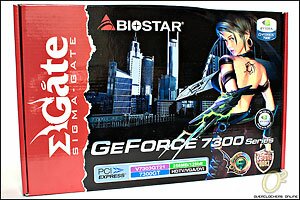
I am not complaining about receiving a package with a scantily clad woman on the front, not many guys are, and that is why we see one on the front of this package. The Sigma Gate logo is the prominent section though and rightfully should be.

Along the bottom of the front cover are the standard GeForce 7300 Series logo and a few badges providing vital details of the card inside including the model number.
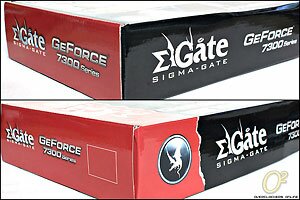
The rest of the box doesn't have a whole lot on it aside from the Sigma Gate and GeForce logos.
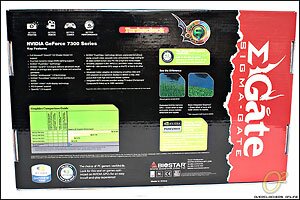
The bottom of the package is pretty much the same as the front but uses the black space for listing features and specifications of the NVIDIA GeForce 7300 series.
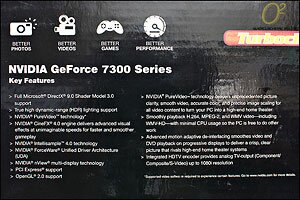
There is actually quite a bit of information about the features of the 7300 series on this package, not something you see a lot of these days.
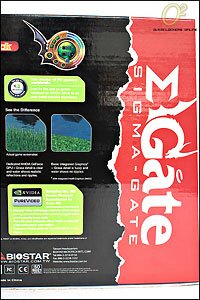
Again Sigma Gate is the primary focal point of the bottom of the package, much like the top. The typical NVIDIA green is present and indicates a strong relationship between Biostar and NVIDIA. Overall the package provides an aggressive feel and fits a video card quite well, especially a powerful little video card like the V7303GT21 that is inside.
Page 3 : Specifications & Features
I mentioned in the Albatron 7300GT specifications page that the 7000 series carries a standard set of features top to bottom which now stretches from the 7100 to 7950 series with the 7300, 7600, 7800, and the 7900 series cards slotted in the middle. The fact that all of these cards, from budget to ultra high-end, carry a very similar feature list that makes the NVIDIA line-up a formidable one at every price range. Here is a list of the features that has been taken from the 7300 features list on the NVIDIA web site.
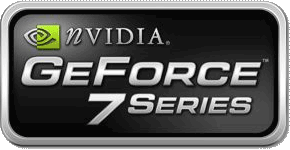
True High Dynamic-Range (HDR) Rendering Support
NVIDIA® TurboCache Technology
NVIDIA® CineFX® 4.0 Engine
PCI Express Certified
NVIDIA® PureVideo Technology
Adaptable Programmable Video Processor
High-Definition MPEG-2 and WMV Hardware Acceleration
Spatial-Temporal De-Interlacing
High-Quality Scaling
Video Color Correction
Integrated TV Output
NVIDIA® ForceWare® Unified Driver Architecture (UDA)
nView Multi-Display Technology
NVIDIA® Digital Vibrance Control® 3.0 Technology
OpenGL® 2.0 Optimizations and Support
Dual 400MHz RAMDACs
Single-Link DVI Support
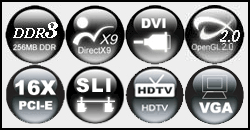
I provided the entire list just to show just how many features NVIDIA is incorporating into this line-up. Obviously most of these terms are just marketing lingo for what every video card has implemented for some time but there are a few big features that stand out including PureVideo and nView Multi-Display Technology. For more information on any of these specific features, feel free to visit the NVIDIA 7300 Features Page.
The specifications of the 7300GT DDRIII from Biostar were pulled from the Sigma Gate section of the Biostar site:
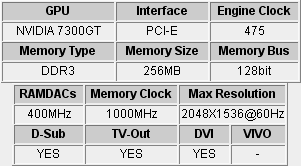
With an effective 1GHz memory clock on the DDRIII memory and a 475MHz core frequency, the performance of this Biostar V7303GT21 should easily exceed that of the Albatron 7300GT DDRII. We will now take a look at the contents of the package from Biostar and the video card itself.
The 7300GT is based on the G73 core which is a 90nm process and has
8 pixel pipelines and 4 vertex shaders
ready for action. This configuration should make it easily competitive to the X800 of old and should match or surpass the 6600GT, its predecessor, in performance.
Page 4 : Contents
When we open the package we are greeted with a cozy looking setup, not unlike most video card package interiors these days.
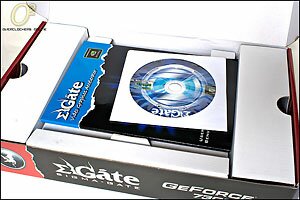
The very thick looking manual and installation CD are on top with the card in a lower compartment I would imagine. The way the corrugated cardboard is setup should provide excellent protection for the card inside.
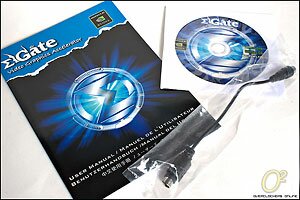
This is all there is for accessories and it obviously isn't much. The only other piece of hardware, aside from the video card itself, is the S-Video to Composite Video dongle. There are no component leads to be found. This is not surprising seeing as this is still considered a budget gaming card and a large accessory package shouldn't be expected.

The manual is so impressive that I gave it an extra photo to show that it not only describes the card but also goes into detail on how to install drivers and other features of the 7300GT. I haven't seen many motherboard manuals with this much detail let alone a video card manual. The information is repeated in a number of languages as well; this adds to the thickness too.
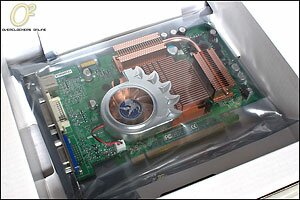
With the smaller pieces removed, we get a look at the GPU inside the package, protected on all sides from any type of shipping harassment it might receive. The card is a perfect fit and the coziness of the interior should keep this card safe no matter who delivers it, even UPS.
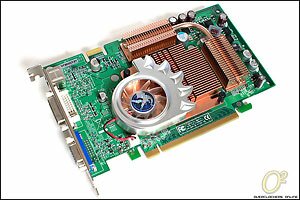
Like magic, the card jumps out of the box and strips itself of the protective ESD bag it comes packaged in. Well… it wasn't really magic, I helped a little bit I guess. It is immediately apparent that the heatsinks used on both the core and memory are made of copper, or a very good imitation if not.
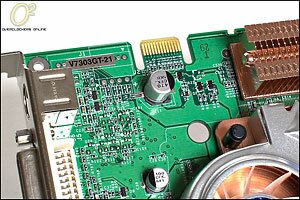
At the top of the card near the front is the sticker confirming the model number of this particular 7300GT which happens to be right beside the SLI bridge connection. That is a dead give away that the card is ready for SLI action.
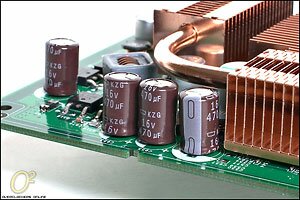
As we move along the top of the PCB we are greeted with a handful of Chemi-Con KZG capacitors which are a Japanese brand and considered to be of a higher quality capacitor proving long term stability and low ESR / high ripple current. These capacitors are at the heart of the power regulation area of the PCB and KZGs are a welcome sight in this position.
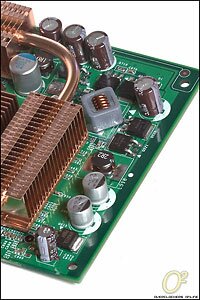
In-behind the KZGs and just below the MOSFETs responsible for regulating the power coming into the video card are some solid aluminum capacitors.
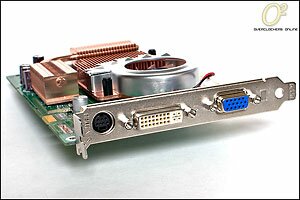
With no VIVO ability there really isn't much to this video card to cover and we quickly find ourselves looking at the outputs offered which I don't go over until I am ready to pull the heatsinks. Clearly marked S-Video at the far left, we have the usual suspects to provide the signal that is being generated onboard down the line with a DVI and VGA output.
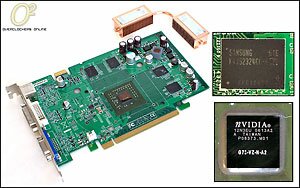
As predicted, it is heatsink pulling time and a bit of work was required to remove the memory heatsink which was just stuck on by the thermal adhesive tape. The contact was good and the heatsink put up a fight to come off which is always a good sign. The GPU heatsink came off with ease using a standard two pushpin setup.
The DDRIII onboard is Samsung part number:
K4J52324QC-BC20
. Here is an excerpt from
Samsung
:
The K4J52324QC is 536,870,912 bits of hyper synchronous data rate Dynamic RAM organized as 8 x 2,097,152 words by 32 bits, fabricated with SAMSUNG's high performance CMOS technology. Synchronous features with Data Strobe allow extremely high performance up to 7.2GB/s/chip.
I/O transactions are possible on both edges of the clock cycle.
Range of operating frequencies, and programmable latencies allow the device to be useful for a variety of high performance memory system applications.
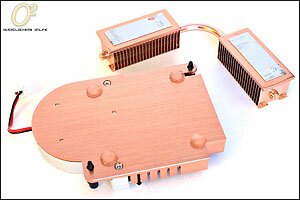
The underside of the GPU heatsink is fairly rough with many grooves running lengthwise on the surface. I don't recommend lapping any GPU heatsink but should temperatures be ridiculously high, this might be necessary. You can see the thermal pads on the memory heatsinks lost a little of their adhesive padding, I told you they were stuck on good. I am fortunate there is no memory still attached to the heatsinks.
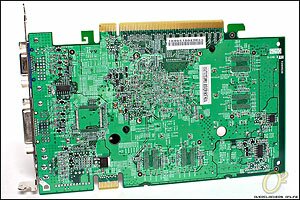
With a very plain and simple cooling setup, the backside of the 7300GT PCB is what you would expect, a mess of traces and enough ICs and SMDs to make a map of Europe look simple. That about covers the contents section so I guess we can install the card in our test setup and get to some real work.
Page 5 : Installation & Overclocking
Like any single slot video card, installation is very straight forward and should not lead to any surprises. The 7300GT series cards are not very long either, barely extending over the actual 16X slot, so this little guy should fit like a glove in the DFI SLI-M2R/G.
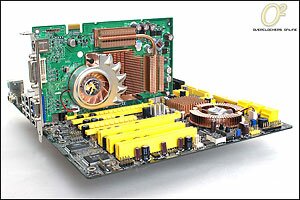
No real shocker here with the card installed and barely taking up any space. The end of the card doesn't even extend out over the passive south bridge and if there was a pair for SLI action, the active heatsink wouldn't have too much hanging over its head. One thing I noticed right away was how the Biostar 7300GTs heatsinks were a perfect color match for the motherboard's heatsinks… that is a lot of copper on this motherboard in total.
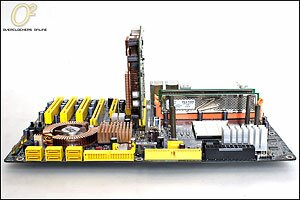
The photo above, taken directly perpendicular to the video card, shows that the slots are fairly tight on the DFI motherboard because the PCI-E 1X slot is still unusable despite the thin cooler on the 7300GT. This is more of a motherboard issue and nothing that Biostar could avoid. You can see I have the memory and waterblock mounts installed so there are just a few more things to hook up and we will be ready for action.
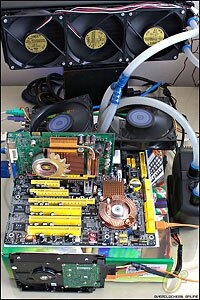
No installation section is complete without a full body shot and that is what we are looking at here. At this point, with the system powered up and video reporting correctly, we can install drivers and start the overclocking to see how much extra we can squeeze out of the Biostar 7300GT 256MB DDRIII.
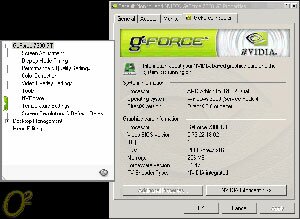
Driver installation went smoothly with the latest available driver from the NVIDIA website and we can see it is ForceWare 91.47. I will be benching both NVIDIA cards with this same driver set for the review.
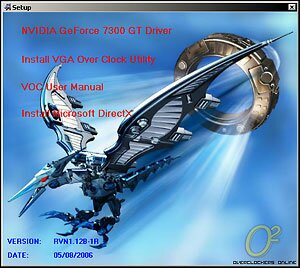
The last of the installation process is the software portion of it and with this package, that means overclocking software. I have never been fond of any manufacturer's bundled overclocking software but I am always willing to try it. Installation is just a couple clicks away and we are ready to go.
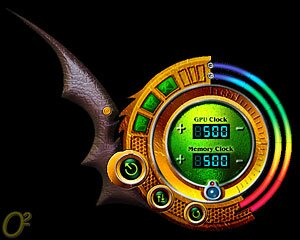
The interface is the typical type of setup where you have to guess or mouse over the buttons, after finding them, to know what they do. We have the options to save and load profiles as well as choose the software to start on boot-up. There is manual overclocking control and a button for automatic overclocking. I tried the auto clocking and within a few seconds got a blue screen and reboot so gave the manual clocking a try. Everything went smooth and using manual controls, the software works well once you figure out what everything does. However, I will be going back to my tried and tested method of Riva Tuner / Coolbits registry hack for the overclocking in this review.
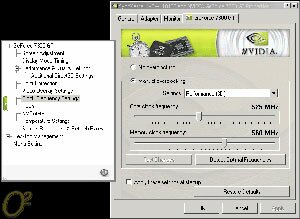
My method of overclocking video cards is as follows:
I manually increase the core 5MHz at a time using multiple benchmarks as stability tests in-between increases such as 3DMark03 and 05. After I find the max stable core frequency, I then lower it back to default and move on to the memory overclocking in the same manor. Stability is determined by being able to do all of the benchmarks without artifacting as well as looping 3DMark05 and 06 graphic tests for a couple hours each. With memory maximum and core maximum found, we combine the frequencies and check for stability again.
I found out something interesting when I went to overclock the Sigma Gate 7300GT DDRIII. The core was defaulting to a frequency of 500MHz and not the 475MHz stated in the specifications. Not sure if it was drivers or just a misprint in the specifications but both the NVIDIA panel and Riva Tuner had the card running at 500MHz for default speeds. The core was able to run up to
525MHz
from the stock 500MHz which isn't amazing but a decent bump seeing as it already comes clocked higher than the standard 7300GT core frequency, and its own specifications. This increase should translate into better performance. The memory, like the core, only overclocks a reasonable amount increasing an effective 120MHz to
DDR1120
from the stock speed of DDR1000. The NVIDIA control panel was able to pass its internal test to allot higher frequencies but complete stability wasn't found until I dropped the frequencies to the levels above.
Page 6 : Test System
Some of the components used for the benchmarks and testing were already provided in the installation section but here is a complete list of the hardware used for this review:
CPU: AMD64 X2 4000+ @ 3000MHz (1.50V)
CPU Cooling: Asetek WaterChill
MB: DFI LanParty NF590 SLI-M2R/G
RAM: OCZ DDR2 PC2 7200 Platinum XTC EPP
PSU: Silverstone Zeus ST56ZF 560W
HD: Seagate SATAII 80GB 8MB NCQ
OS: Windows XP SP2 (with all updates)
Video Cards:
HIS X800GTO IceQ II Turbo 256MB – Catalyst Control Center 6.2
PowerColor X1300Pro 256MB – Catalyst Control Center 6.2
Albatron 7300GT 256MB DDRII – ForceWare 91.47
Biostar 7300GT 256MB DDRIII
– ForceWare 91.47
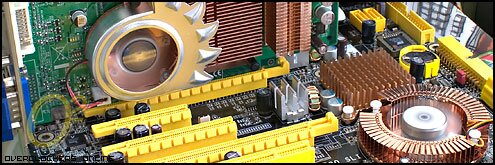
One aspect of testing I like to do is to see how much heat the card puts out while under load for extended periods of time. This gives us a good idea of how well the cooling on the video card is. Ambient temperature during the run time was 23-24C the entire time.
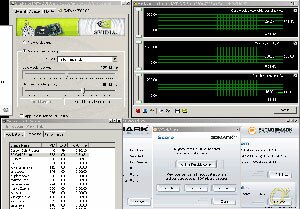
As you can see, I just looped the 3DMark05 3D tests for 30 minutes and had Riva Tuner record temps for us. I did this testing with the card in its overclocked state and you can see by the screenshot above, temperature at the core never crossed over 46C. At idle I would only get about 37C~39C so a delta of less than 7C was found in looping 3DMark05 3D tests. That is pretty impressive but with temperatures that low, I was expecting the ability to crank the core a little more. As it stands, we know what the maximum stable overclock is so we can move on to some benchmarks, I start with the synthetic results.
All benchmarks were run 3 times and the results averaged for the graphs on the following pages. The synthetic results were run manually with some of the gaming benchmarks run using Bench'em All with custom time demos. F.E.A.R. benchmark results were derived by simply running the built in test and the Battlefield 2 results came from the benchmark program found at Guru 3D.
Page 7 : Synthetic Performance
As I stated earlier, the benchmarks were run 3 times and the results averaged. I have marked the clock speeds of the Biostar 7300GT but left the clock speeds of the other cards out of the charts. The other cards ran all of the benchmarks, both synthetic and gaming, at there stock speeds.
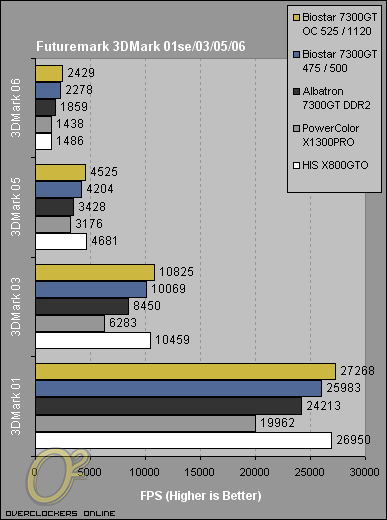
3DMark01 isn't the best gauge for a video card because system performance heavily influences the results. With that said, 3DMark01 still shows decided advantages to better video cards. We get our first look at the performance difference the DDRII memory on the Albatron 7300GT and the superior DDRIII model of our Biostar 7300GT with the 3DMark 03 and 05 results. In 3DMark03, the Biostar 7300GT DDRIII competes neck and neck with the X800GTO and actually surpasses it when overclocked.
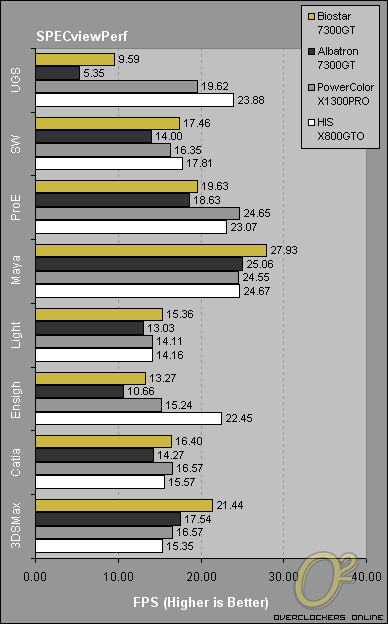
The Spec view results confirm again that the Biostar DDRIII model is much stronger than the Albatron DDII version. For Spec View I only benchmarked at the stock speeds and every program shows an easy win to the DDRIII version of the 7300GT. I think it is safe to say that we should fully expect an outright win for the Biostar 7300GT DDRIII in the gaming results and I almost expect the Biostar 7300GT to give the X800GTO a run for its money.
Page 8 : Battlefield 2 Benchmarks
I won't change the way I benchmark Battlefield 2 because it is the only way to get repeatable and realistic benchmark results using a custom time demo, but man is it a hassle. I have to thank Guru3D.com one more time for the script that runs the demo because it has proved to be invaluable. The detail levels have all been cranked to the highest possible so there is plenty of room to bring the FPS up without sacrificing a lot of quality in BF2 with these cards.
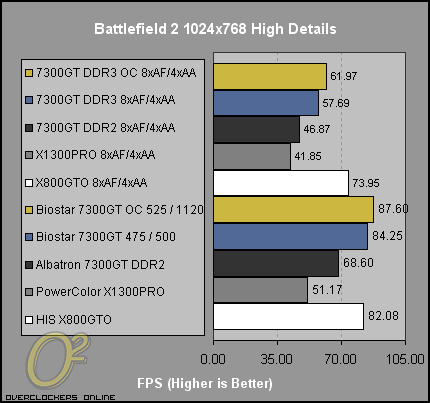
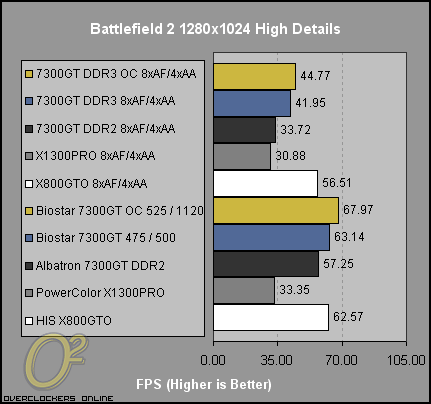
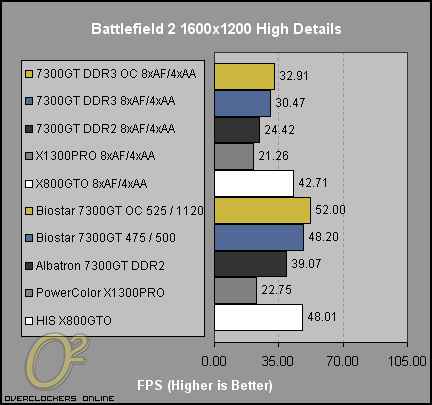
Top to bottom, the Biostar 7300GT is head of the class in BF2… until the AA and AF get turned on. The drop off in performance is not as great with the ATI X800GTO as it was with both 7300GT cards. This makes me believe that it has more to do with drivers and the architecture differences between ATI and NVIDIA cards. Regardless, without AA or AF turned on the Biostar 7300GT DDRIII stayed in front of the X800GTO at all three resolutions, even at the stock speeds before overclocking occurred.
Page 9 : Doom III Benchmarks
An oldie but goodie, DOOM III still has the uncanny ability to stop video cards in their tracks with heavy shader use. This dark and moody first person shooter is an excellent gauge for video card performance. With NVIDIA cards outperforming ATI based video cards handily due to superior OpenGL support, the benchmarks are a bit biased toward the 7300GTs so worry more about the comparison between those two cards. Detail settings were again set to the maximum for both non AA/AF and AA/AF runs.
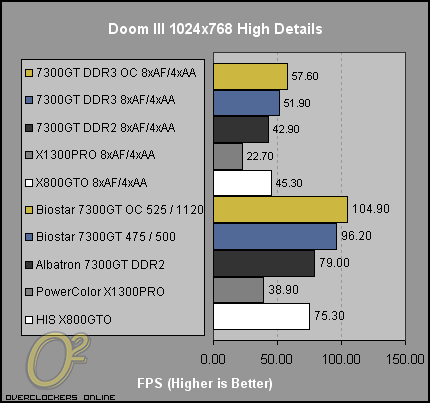
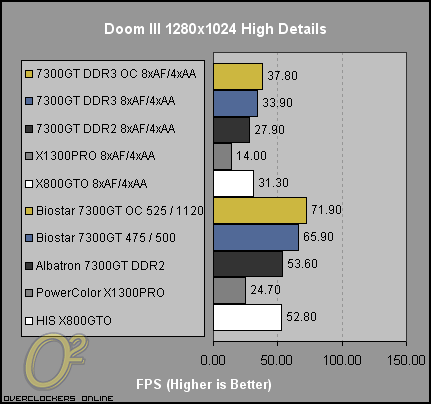
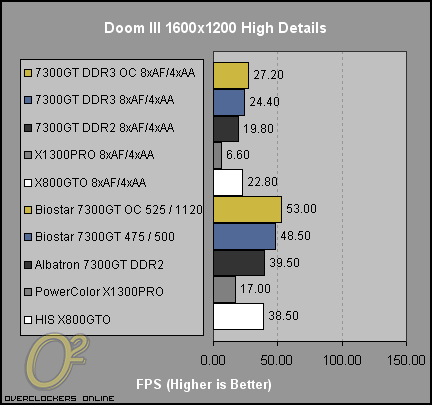
It is safe to say that at even at 1600×1200, Doom III is more than playable with the Biostar 7300GT before turning AA/AF on. The gap between the two 7300GTs is a solid 10FPS ~ 17FPS when both running at stock speeds depending on the resolution, the DDRIII model with higher clocks is clearly superior in the benchmarks we have seen, and a worth while upgrade in my opinion.
Page 10 : Far Cry Benchmarks
Much like Doom III, one architecture appears as a decided winner but this time it is ATI that has the advantage with the X800GTO pulling way out ahead of the 7300GT cards. The detail levels were pinned to the maximum for all benchmarks like the rest of the game that were benchmarked.
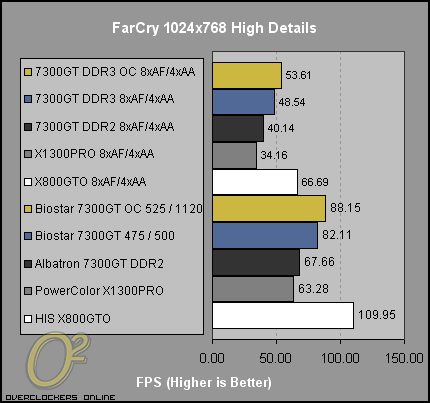
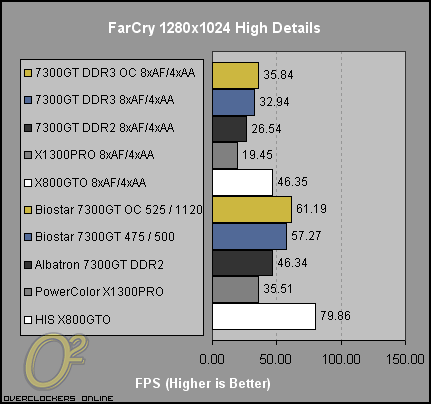
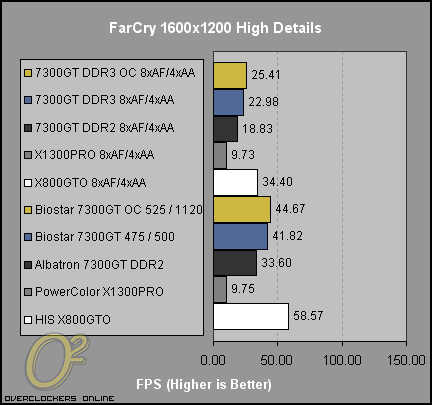
Normally Far Cry is more dependant on system performance up to a certain level and we can see from the stock to overclocked results of the Biostar 7300GT that the difference isn't as great, indicating less of a dependence on GPU and more of the performance based on the system. Despite this dependency on the system, the AA/AF results take a large hit in FPS and lowering the detail levels is definitely required with a mid-range card such as the 7300GT.
Page 11 : Half-Life 2 Benchmarks
HL2 is another one of those games that doesn't lean on the GPU as much as some of the others we have looked at. Because of this the FPS will be a good bit higher than some games like Doom III or F.E.A.R. because the test system is pretty hefty and has no problems keeping the FPS right up there, even with AA and AF turned on. Here is what I found for HL2:
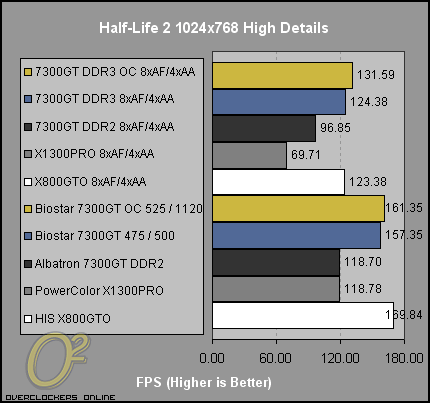
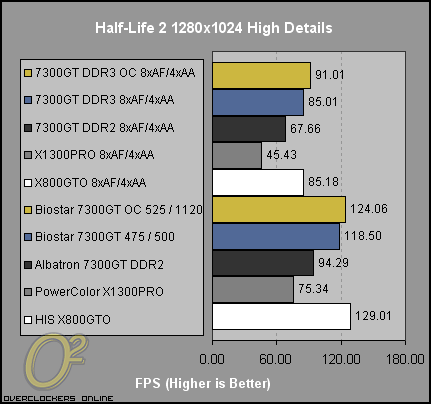
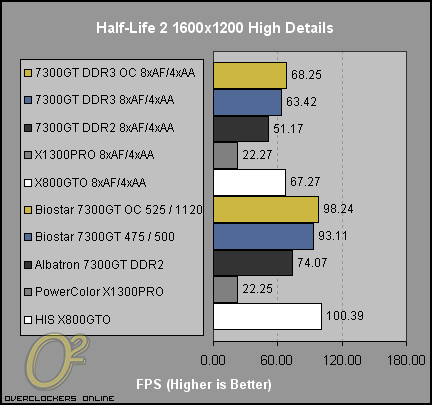
The results are a little bit mixed if you strictly look at the numbers with the ATI X800GTO showing slightly better performance without AA/AF and with AA/AF enabled, the 7300GT pulls ahead ever so slightly. This is likely due to the drivers again or perhaps the NVIDIA cards just handle the added work load better. However you look at it though, the Biostar 7300GT DDRIII bests or equals the X800GTO in Half-Life 2. This is becoming a common theme and the picture of the performance the 7300GT is capable of starts to reveal itself.
Page 12 : F.E.A.R. Benchmarks
I noted earlier that the in-game test was used for the results below and the graphs indicate an even playing field between both ATI and NVIDIA cards. Detail levels were set to high but soft-shadows were turned off as the benefits are not that great and they can really crush the performance of a mid-range or lower end card in F.E.A.R.
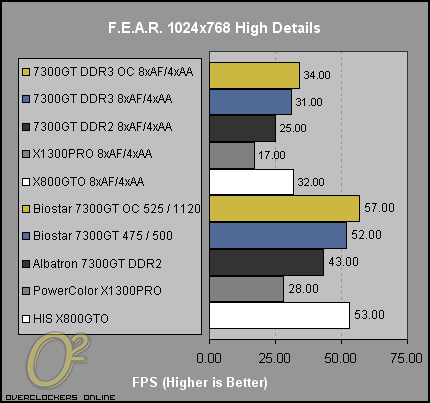
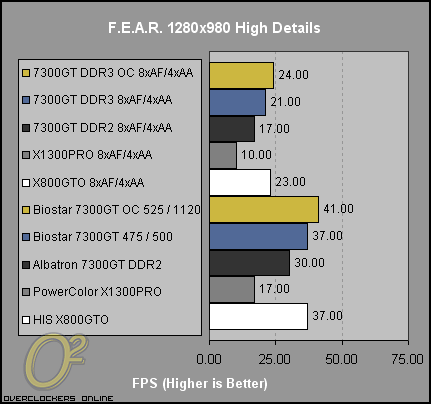
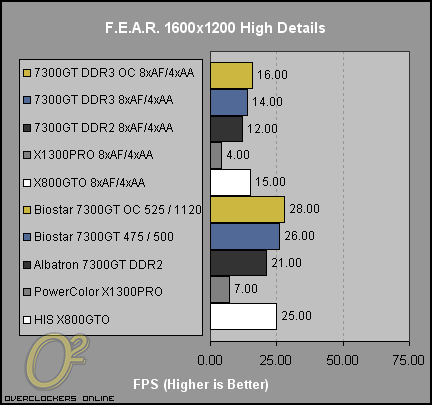
With the even playing field, the Biostar 7300GT DDRIII goes nose to nose with the X800GTO right through the resolution range and pulls ahead once the overclocked settings are implemented. We do however notice a slightly higher drop off in the 7300GT performance when the Anti-Aliasing and Anisotropic Filtering are enabled. This really isn't much of an issue as none of these cards will be running F.E.A.R. with AA/AF on anyone's machine.
Page 13 : Conclusion
This is the second 7300GT I have reviewed in as many months and since the last was a DDRII model, I was expecting better performance out of the DDRIII model. Not only was the memory faster but the core also comes clocked higher out of the box. Despite this elevated expectation, the Biostar Sigma Gate 7300GT 256MB DDRIII never let me down in the slightest bit.
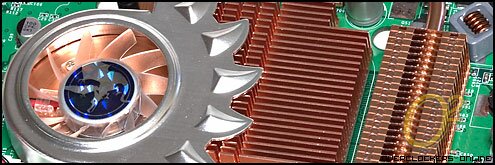
The performance advantages over the DDRII model are apparent in all the benchmarks ran, both synthetic and actual gaming. This is no doubt a by-product of the higher core clocks and superior memory onboard. The cooling solution on the V7303GT21 is excellent, keeping temperatures extremely low and showing very little delta between idle and load temperatures. I have only had the video card for a few weeks but there certainly isn't any excessive noise coming from that area.
I honestly don't have any complaints with the Biostar Sigma Gate 7300GT and the performance speaks for itself. If anything, some people would like to see a bigger accessory and/or software package but those things do not carry any weight in my purchasing decisions and if it keeps the price down by excluding them, I am all for it. If retailers hit the MSRP of $110USD or lower then this is definitely a card to look at for those looking to play games without having to steal money out of their grandma's purse when she is not looking.
Advantages
- Excellent performance for around $100
- Overclocking headroom is fairly good on the memory
- Cooler doesn't scream for attention
Disadvantages
- Package accessories are limited with only Composite and S-Video outs
- Bundled overclocking was unable to overclock automatically
Overclockers Online would like to thank Biostar for making the Sigma Gate 7300GT review possible.